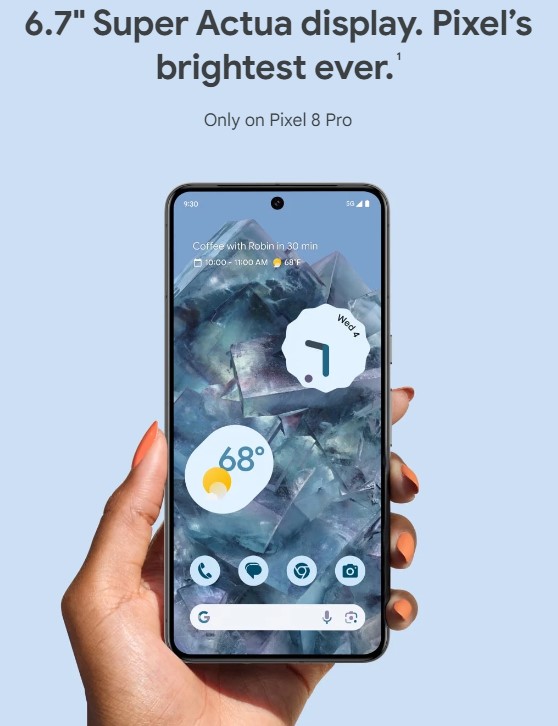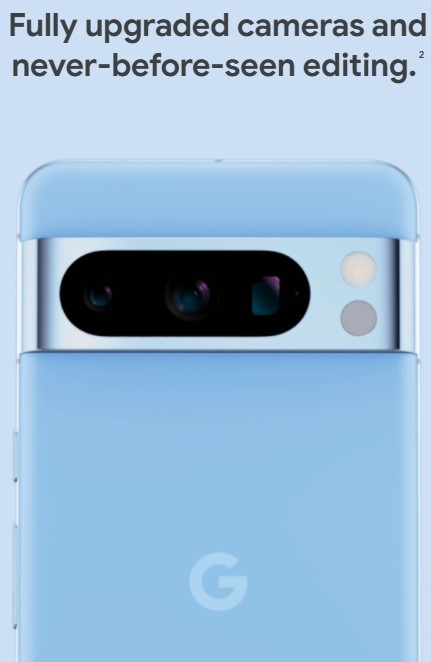Introducing the Google Pixel 8 Pro, the latest flagship smartphone from Google that builds upon the success of its predecessor, offering both a regular model and a pro variant. In this detailed exploration, we will delve into the nuanced features, improvements, and potential drawbacks of the Pixel 8 Pro, covering everything from design and display to performance, camera capabilities, and battery life.
Design and Display:
The Pixel 8 Pro boasts a 6.7-inch display, positioning it as a larger and more feature-rich option compared to its regular counterpart. This display shines with a peak brightness of 2400 nits, making it one of the brightest displays globally and reaching 1600 nits when viewing HDR content. The addition of a new CPU, the Google Tensor G3, sets the stage for improved performance, which we will discuss in detail later. The flat display design is a welcome feature for users who prefer a more traditional screen surface, deviating from the trend of curved displays that can sometimes hinder grip.

Available in three colors—Bay (blue), black, and porcelain (warm white)—the Pixel 8 Pro showcases frosted glass backs. While frosted glass can enhance grip, the phone’s top-heavy design and overall weight (213 grams or 7.2 ounces) may make it feel slightly cumbersome, particularly during activities like gaming. The potential slipperiness and weight distribution issues suggest the necessity of using a case for a more secure hold.
Distinguishing Between Pixel 8 and Pixel 8 Pro:
Understanding the differences between the regular Pixel 8 and the Pro model is crucial for potential buyers. The Pixel 8 Pro introduces a telephoto lens, providing users with enhanced zoom capabilities, a feature absent in the regular Pixel 8. Additionally, the Pro model offers an advanced manual mode for the camera, allowing users to customize settings like ISO and shutter speed—a feature excluded from the regular Pixel 8.

Pricing for the Pixel 8 Pro starts at $999 for the base model with 128GB of storage. Incremental storage upgrades, ranging from 256GB to a maximum of 1TB, incur an additional cost of around $60 per increment. In comparison, the regular Pixel 8 is priced at $699, offering a more budget-friendly option for users with different storage needs.
Performance and Benchmarking:
The Pixel 8 Pro comes equipped with 12GB of low-power DDR5X RAM, contributing to its smooth and responsive performance. The Google Tensor G3 CPU, while potentially lagging behind the latest Snapdragon 8 Gen 2 processor in benchmark results, ensures an experientially satisfying performance. Pixel phones have historically felt sprightly due to effective optimization and minimal bloatware, facilitating seamless use for various applications and gaming experiences.

While the decision to block benchmarking apps until the day after the phone’s release raises questions about transparency, the overall performance of the Pixel 8 Pro, especially in real-world usage scenarios, remains commendable. The phone adeptly handles demanding tasks such as playing resource-intensive games like Genshin Impact and Call of Duty Mobile. Furthermore, the emphasis on AI features, from camera enhancements to innovative functionalities like phone tree navigation, showcases Google’s commitment to integrating artificial intelligence into the user experience.
Connectivity and Android Updates:
The Pixel 8 Pro supports 5G connectivity, encompassing both millimeter-wave and sub-6, ensuring users have access to high-speed data networks. With a nano-SIM slot and an eSIM, the phone offers flexibility in network options. Running Android 14 out of the box, the Pixel 8 Pro introduces a promising feature—a guarantee of seven years of updates, encompassing OS updates, security patches, and feature drops. This commitment to prolonged support aligns with users’ expectations and may set a new standard in the Android ecosystem.

Battery Life and Charging:
Powered by a 5,050mAh battery, the Pixel 8 Pro addresses concerns about battery life, a notable improvement over its predecessor, the Pixel 7 Pro. The battery life has seen an approximate 25% enhancement, delivering a more reliable and enduring performance. While specific run times can vary based on individual usage patterns, the overall improvement signifies a step forward in addressing historical concerns about Pixel phone battery life.
Charging capabilities include a USB-C 3.2 port, wireless charging, and fast wireless charging, which has seen a notable speed boost. The Pro model supports 30 Watts for wireless charging, while the regular Pixel 8 offers 27 Watts. These charging enhancements contribute to a more efficient and user-friendly charging experience.
Heat Management:
Concerns about potential overheating, especially with the Tensor CPU, are alleviated as the Pixel 8 Pro does not exhibit burning-hot temperatures. However, warmth is noticeable around the camera bar area during certain activities, signaling that Google might be prioritizing thermal management over pushing clock speeds to the extreme. While the warmth is not uncomfortable, it remains a noteworthy aspect for users sensitive to temperature variations during prolonged usage.
In conclusion, the Google Pixel 8 Pro presents itself as a compelling flagship smartphone, offering an array of enhancements over its predecessor. From a brilliant display and improved camera features to commendable performance and battery life, the Pixel 8 Pro caters to users seeking a robust Android experience. While certain design considerations, such as the top-heavy feel and potential slipperiness, may require additional precautions, the overall package positions the Pixel 8 Pro as a noteworthy contender in the competitive smartphone landscape.

In the realm of smartphones, the Google Pixel 8 Pro emerges as a device that not only builds upon its predecessor’s successes but addresses certain drawbacks, offering an enhanced user experience across various facets. From an improved speaker system to a refined display and upgraded camera features, this comprehensive exploration aims to provide insights into the nuanced aspects of the Pixel 8 Pro.
Display and Speaker Improvements:
The Pixel 8 Pro showcases notable advancements in its display and speaker systems, two components that significantly impact user satisfaction. The display, despite boasting a staggering 2400 nits of maximum peak brightness, surpasses mere numerical brilliance. It stands out as a genuinely impressive feature, offering vibrant and natural colors. Google’s commitment to a more natural color profile, as opposed to the super-amped-up OLEDs found in some competitors, contributes to a viewing experience that aligns with user preferences for more authentic tones.

Moreover, the once-criticized curvy display has undergone refinements, addressing concerns from previous iterations. The overall display quality, coupled with the flat design, diminishes the need for constant comparison with competitors like the Galaxy S23 Ultra or iPhone 15 Pro Max. The user is left with a bright, colorful, and visually appealing OLED display, devoid of any remorse for not opting for other flagship models.
Simultaneously, the Pixel 8 Pro tackles one of its predecessors’ pain points—the speakers. With a newfound loudness and richness, the speakers elevate the audio experience, making it genuinely enjoyable for users. The culmination of display and speaker improvements contributes to a holistic upgrade in multimedia consumption.

Connectivity and Modem Performance:
Questions often arise about the efficacy of a smartphone’s connectivity, particularly concerning 4G and 5G capabilities. In the Pixel 8 Pro, while no groundbreaking advancements are witnessed in the modem, the overall performance remains solid. Reception, primarily on 5G networks, demonstrates usability, with occasional fallbacks to 4G LTE, which may not match the stellar performance of competitors like the S23 Ultra or the latest iPhones. Despite this, the connectivity remains functional, and while not class-leading, it satisfies the needs of the average user.
Camera Enhancements:
Undoubtedly, the Pixel series has earned acclaim for its camera capabilities, and the Pixel 8 Pro continues this legacy with a myriad of improvements. The camera setup includes a 50-megapixel main camera, a 48-megapixel ultra-wide-angle lens that doubles as a macro shooter, and a 48-megapixel telephoto lens. All these lenses support 4K video capture, ensuring versatility in various shooting scenarios.

The Pixel 8 Pro’s cameras are not merely a hardware showcase but a testament to Google’s prowess in software and AI integration. The AI features, coupled with innovative functionalities like the magic eraser, offer users a unique and engaging photography experience. While the phone does provide a manual mode for enthusiasts, the primary appeal lies in the naturalistic approach to photography. The color accuracy and avoidance of over-amping or oversharpening set the Pixel 8 Pro apart in a market saturated with devices that often prioritize exaggerated visual effects.
The software’s post-processing capabilities, such as shadow adjustments and the magic eraser tool, further empower users to refine their photographs. However, the ease with which photos can be manipulated raises questions about the authenticity of the visual content produced by the device.
Overall Assessment:
In summation, the Google Pixel 8 Pro positions itself as a compelling choice for users who appreciate the Pixel experience. The iterative improvements, ranging from better speakers and display enhancements to camera upgrades, collectively contribute to a well-rounded smartphone. Google’s commitment to addressing previous criticisms, evident in the attention to detail regarding speaker quality and display design, showcases a dedication to user satisfaction.
While certain aspects, such as connectivity performance, may not outshine direct competitors, the Pixel 8 Pro presents a cohesive package that caters to those seeking an authentic and enjoyable Android experience. The device successfully incorporates advancements from its predecessor, making it a worthy consideration for users who prioritize camera quality, multimedia consumption, and the overall Pixel ecosystem. As always, individual preferences play a crucial role in the decision-making process, and those aligned with the Pixel ethos are likely to find the Pixel 8 Pro to be a commendable addition to Google’s smartphone lineup.
Google Pixel 8 Pro
-
Performance - 96%96%
-
Price - 98%98%
-
Value - 97%97%

